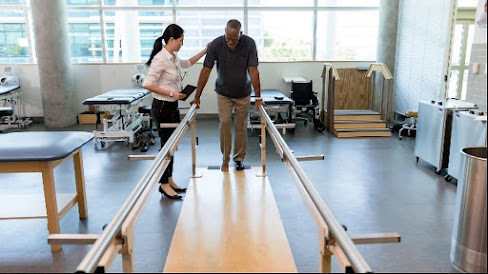Neurorehabilitation : Restoring Function and Quality of Life
Neurorehabilitation in physiotherapy is a specialized area of rehabilitation that focuses on helping individuals recover physical function and improve their quality of life after neurological injuries or conditions. Neurological conditions can include stroke, traumatic brain injury, spinal cord injury, multiple sclerosis, Parkinson’s disease, and various other disorders that affect the central nervous system. Neurorehabilitation is a multidisciplinary approach involving physiotherapists, occupational therapists, speech therapists, and other healthcare professionals.
Here are some key aspects of neurorehabilitation in physiotherapy:
1. Assessment and Evaluation: The first step in neurorehabilitation is a comprehensive assessment to understand the patient’s specific impairments, limitations, and goals. This assessment includes evaluating motor control, strength, balance, coordination, sensation, and functional abilities.
2. Goal Setting: Once the assessment is complete, specific rehabilitation goals are established in collaboration with the patient and their family. These goals should be realistic, measurable, and individualized to the patient’s needs and abilities.
3. Treatment Planning: A tailored treatment plan is developed based on the assessment and the established goals. The treatment plan may include various therapeutic techniques and exercises.
4. Motor Control and Strength Training: Physiotherapists work on improving muscle strength, flexibility, and motor control in affected areas. This may involve exercises, manual therapy techniques, and the use of specialized equipment.
5. Balance and Coordination: Balance and coordination are often compromised in neurological conditions. Therapists use specific exercises and activities to help patients regain their ability to maintain balance and coordinate movements.
6. Gait Training: For individuals with walking difficulties, gait training is a crucial component of neurorehabilitation. This includes practicing walking with or without assistive devices and addressing any abnormalities in gait patterns.
7. Functional Training: Neurorehabilitation aims to improve a patient’s ability to perform daily activities independently. Therapists work on tasks like dressing, bathing, cooking, and mobility in a home environment.
8. Modalities: Physiotherapists may use various modalities such as electrical stimulation, heat or cold therapy, and hydrotherapy to aid in the rehabilitation process.
9. Neuromuscular Reeducation: This involves techniques to help patients relearn and reinforce motor patterns that may have been disrupted by neurological damage.
10. Patient Education: Education plays a significant role in neurorehabilitation. Patients and their families are provided with information on their condition, strategies for managing symptoms, and techniques for preventing complications.
11. Home Exercise Programs: Patients are often given home exercise programs to continue their rehabilitation independently between therapy sessions.
12. Psychosocial Support: Coping with neurological conditions can be emotionally challenging. Therapists provide emotional support and strategies for managing psychological aspects of rehabilitation.
13. Progress Monitoring: Regular assessments and adjustments to the treatment plan are made to track progress and modify interventions as needed.
Neurorehabilitation in physiotherapy is a complex and ongoing process that requires a collaborative effort among healthcare professionals, patients, and their families. The ultimate goal is to help individuals with neurological conditions regain as much function and independence as possible, improving their overall quality of life.


Comments
Post a Comment